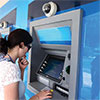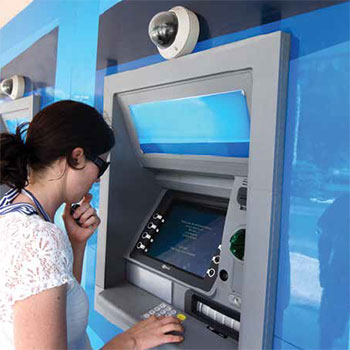
Keeping Assets Well Protected
Technology bolsters security and business practices in the financial vertical
- By Joe Pellettiere
- Feb 01, 2014
 There are tens of thousands of bank branches and financial services
locations throughout the world. The business environment itself is
complex, as it combines elements of high-end commercial services
with a frontline, retail component. A single, large bank, for example,
might have thousands of locations, even more ATM locations and
each facility can present a variety of unique security needs.
There are tens of thousands of bank branches and financial services
locations throughout the world. The business environment itself is
complex, as it combines elements of high-end commercial services
with a frontline, retail component. A single, large bank, for example,
might have thousands of locations, even more ATM locations and
each facility can present a variety of unique security needs.
A main security challenge facing the banking world includes a need to protect
thousands of geographically-dispersed sites, including various property types and
threat levels. In addition to the need for overarching corporate security, banks and
financial institutions must protect individual facilities such as retail banking locations,
ATM services, cash vault operations and data centers. Security practitioners
in this market require centralized management of security functions, but limited,
wide area network (WAN) connectivity can present an obstacle to effective, networked
operations.
At the corporate level, banks and financial institutions leverage video surveillance
systems in conjunction with security personnel to protect and control access
to premises while reducing the opportunity for fraud. Networked-based video systems
are called on to interface with access control, intrusion alarm and environmental
systems. Monitoring centers must be able to easily manage displayed video
on multiple monitors and draw guards’ attention to events that need immediate
assistance.
A comprehensive, end-to-end, IP video system can offer a proactive approach
to security. Intelligent devices and security analytics, integrated with other systems
and operating as a unified platform, represent the cutting edge of security technology
for the financial sector, and many users are just beginning to test these new
solutions. Integrated security analytics can simplify the administration of video
systems, expedite investigations and offer business tools and added intelligence.
Powerful notification and response combined with real-time analytics offers a
proactive approach to security management unlike any other this vertical market
has ever seen.
The Ultimate Goal
At bank branches, security systems protect against robbery and fraud while ensuring
employee and customer safety. Cameras are needed to view teller positions,
drive-up lanes and provide overviews of the branch location. Some areas, such as
cash drops and ATM vestibules, require 24-hour access, and cash vaults store large
amounts of cash, making them a high risk area for internal theft or external attack.
Therefore, high-quality video images are required to provide sufficient detail.
Some bank branches, though, may not have an on-site security staff so video is
often viewed remotely.
In-demand features and benefits include the ability to view video alongside
events and on multiple cameras associated with events simultaneously. Multiple
DVRs on a single site or across multiple sites can be managed as a complete system.
Thumbnail searches can locate video quickly, if it isn’t associated with an
event. Privacy masking protects sensitive areas, such as PIN pads and vault combinations,
an increasingly popular feature given the increase in usage of megapixel
cameras that capture greater detail. Other features include instant alerts and surveillance
analytics.
As systems must be scalable to meet today’s security requirements and future
goals, systems have to be camera-agnostic, support a range of analytic rules and
integrate with other network platforms to address individual retail banking and
corporate facility’s needs. Banks can purchase only the analytics they need now
and add more as necessary in a seamless solution. Maximum capabilities include
automatic and time-critical detection of rules violations and high probability of
detection with low false alarm rates.
A New Level of Intelligence
Banks want solutions to increase security intelligence and situational awareness
for its banking customers by including embedded video analytics, investigative
management tools, enterprise-based, fraud analytics, and license plate recognition
and facial detection.
Integrated, security analytics simplify administration of video systems and expedite
investigations. Powerful notification and response combine with real-time
analytics to offer a proactive approach to security management. Surveillance platforms
that deliver an open, scalable approach deliver lower total cost of ownership
(TCO) and ease of operation in a robust video and situational intelligence
management suite.
Surveillance analytics can help security staff prioritize and automatically escalate
video from cameras that have detected rule(s) violations, showing people or
objects presenting pre-defined risks that may include crossing a pre-defined perimeter
or line, an object left behind, loitering or movement within a restricted area,
while license plate searches are easy to accomplish across multiple locations.
Drive Business Growth
Banks and financial institutions seek a competitive edge and increasingly look to
technology to provide it. Today’s IP-based video security systems can help analyze
customer activity with accurate people counting, track customer behaviors such as
dwell and wait times, and analyze branch activity.
Retail administration can use the video system to view activity at lobbies of
various branches as a tool to ensure better customer service. For instance, should
one branch experience an especially heavy volume of business, tellers can be
swapped as needed to ensure coverage.
Related to compliance, federal law requires reporting of any cash deposits of
more than $10,000, a regulation aimed at preventing tax evasion and money laundering.
However, to skirt the regulation, some people might resort to “structuring,”
which means making multiple small deposits at various branches. If there
are excessive deposits into a single account, a bank’s compliance personnel can get
involved to track down who is making the deposits.
Always There
Users expect video systems to be reliable and offer “continuity of video coverage.”
Because video surveillance in the financial sector typically involves many cameras,
especially multiple branches monitored from a central location, a big challenge is
how to distill and prioritize important events or situations out of hundreds, even
thousands, of video feeds captured every day.
Video coverage is critical when a theft occurs or when a bank experiences violent
issues, as its surveillance system needs to make it easy to export video and
transmit it to authorities. The time saved versus needing to “burn” a DVD can be
critical in the hurried aftermath of a robbery, for example. The focus needs to be
on helping employees and customers deal with the impact of an incident, rather
than trying to deal with a complicated export process.
Changing Tides
The financial industry has long been an attractive target for crime. Of course the
financial market is home to untold amounts of money, but there’s another reason
criminals are drawn to the financial world: the enormous number of transactions
that occur every day. Every ATM deposit or withdrawal, online money transfer or
credit card purchase represents an opportunity for fraud—and criminals know it.
All sizes of financial institutions face the risk of bank and ATM robberies, card
“skimming” scams, credit and debit card fraud, and more. With fraud especially
on the rise, point-of-sale skimming still occurs, but malware has taken center stage.
Criminals are increasingly using it to penetrate financial records and private information,
and they’re reaping enormous amounts of money for their efforts.
Malware is particularly troubling because it can be used at any time, from anywhere,
and doesn’t require a fraudster’s physical presence. Increasingly, criminals
obtain another person’s financial data online —including passwords and PINs—
with sophisticated software and, in some cases, weak passwords. They then create
fake IDs, credit cards or debit cards, and extract cash at an ATM, buy easily resellable
items at a grocery or home goods store, or go shopping online.
Malware that specifically targets mobile devices is also growing in popularity.
Mobile malware increased an overwhelming 614 percent in the last year, with Android
operating systems receiving 92 percent of threats.
Video surveillance proves its value every day at financial institutions across the
country and around the world. Growing adoption of new video
capabilities will continue to unlock greater value, keeping financial
institutions more secure and effectively empowering them
with new operational efficiencies.
This article originally appeared in the February 2014 issue of Security Today.